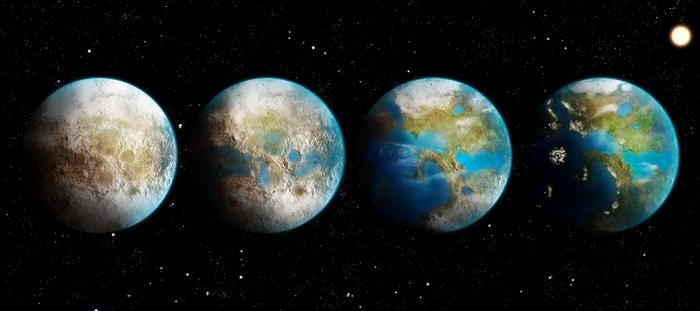A groundbreaking study from the University of California, Riverside suggests that we might be able to detect signs of alien civilizations terraforming planets in distant solar systems. The research, published in The Astrophysical Journal, identifies specific artificial greenhouse gases that could be telltale signs of intelligent life modifying a planet’s climate.
These gases, detectable even at low concentrations using existing technology like the James Webb Space Telescope, could serve as “technosignatures” – indicators of technology-using life forms beyond Earth. The study opens up new possibilities for the search for extraterrestrial intelligence (SETI) and highlights the advancing capabilities of our space observation technology.
The Greenhouse Gases That Could Reveal Alien Engineers
The research team, led by UCR astrobiologist Edward Schwieterman, identified five gases as potential technosignatures. These include fluorinated versions of methane, ethane, and propane, as well as gases made of nitrogen and fluorine or sulfur and fluorine. All are used in industrial applications on Earth, such as computer chip manufacturing.
“For us, these gases are bad because we don’t want to increase warming. But they’d be good for a civilization that perhaps wanted to forestall an impending ice age or terraform an otherwise-uninhabitable planet in their system, as humans have proposed for Mars,” Schwieterman explained.
These gases have several advantages as terraforming agents. They are incredibly potent greenhouse gases – sulfur hexafluoride, for example, has 23,500 times the warming power of carbon dioxide. They are also exceptionally long-lived, persisting in an Earth-like atmosphere for up to 50,000 years.
From Thought Experiment to Potential Discovery
To test the feasibility of detecting these gases, the researchers simulated a planet in the TRAPPIST-1 system, about 40 light-years from Earth. They found that with an atmosphere similar to Earth’s, these gases could be detectable even if they made up only one out of every million molecules.
The study also considered the potential of future missions, such as the European LIFE mission, which would be able to directly image planets using infrared light. This capability could allow for the examination of even more exoplanets than current telescopes.
While the likelihood of finding these gases in the near future remains uncertain, the researchers are optimistic about the possibilities. “You wouldn’t need extra effort to look for these technosignatures, if your telescope is already characterizing the planet for other reasons,” said Schwieterman. “And it would be jaw-droppingly amazing to find them.”
Daniel Angerhausen, a collaborator from the Swiss Federal Institute of Technology/PlanetS, emphasized the historical significance of this research: “Our thought experiment shows how powerful our next-generation telescopes will be. We are the first generation in history that has the technology to systematically look for life and intelligence in our galactic neighborhood.”
As our space observation technology continues to advance, the search for extraterrestrial life is moving from the realm of science fiction to cutting-edge science. This study not only provides a new tool for SETI researchers but also highlights how far we’ve come in our ability to peer into the cosmos and potentially answer one of humanity’s most profound questions: Are we alone in the universe?
If our reporting has informed or inspired you, please consider making a donation. Every contribution, no matter the size, empowers us to continue delivering accurate, engaging, and trustworthy science and medical news. Independent journalism requires time, effort, and resources—your support ensures we can keep uncovering the stories that matter most to you.
Join us in making knowledge accessible and impactful. Thank you for standing with us!

